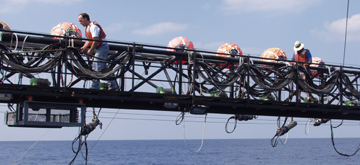 In the fall
of 2002, the R/V Maurice Ewing halted a seismic survey in the Gulf of
California after two whales beached on the Baja side of the sound. An environmental
group sued, saying that the sound from the ship’s array of air guns disturbed
the marine mammals. The incident is one of many in an ongoing controversy over
the effects of human-made sounds on marine mammals. Partly in response to that
event, scientists have quantitatively measured the acoustic levels of the Ewing’s
seismic air-gun array in the Gulf of Mexico. Their results indicate the potential
need for a revision of acceptable levels for seismic arrays depending on water
depth, as well as the need for further experiments.
In the fall
of 2002, the R/V Maurice Ewing halted a seismic survey in the Gulf of
California after two whales beached on the Baja side of the sound. An environmental
group sued, saying that the sound from the ship’s array of air guns disturbed
the marine mammals. The incident is one of many in an ongoing controversy over
the effects of human-made sounds on marine mammals. Partly in response to that
event, scientists have quantitatively measured the acoustic levels of the Ewing’s
seismic air-gun array in the Gulf of Mexico. Their results indicate the potential
need for a revision of acceptable levels for seismic arrays depending on water
depth, as well as the need for further experiments.Workers on the R/V Maurice Ewing deploy a seismic air-gun array for experiments conducted last fall, to calibrate how the array’s sound waves travel underwater at different depths. The results have been incorporated into the ship’s operations for protecting marine mammals. Photo courtesy of John Diebold, LDEO.
An air gun forces a burst of compressed air into the ocean in a bubble that expands and contracts, creating a reverberating sound. Common in seismic surveys, air gun arrays face straight down in order to send and recapture soundwaves from below the seafloor, where sediments reflect the waves at different velocities.
In an effort to understand how sound travels from the Ewing’s seismic array, a team led by Maya Tolstoy of Columbia University’s Lamont-Doherty Earth Observatory in Palisades, N.Y., tested the ship’s air guns in a variety of configurations at one shallow- and one deep-water site in the Gulf of Mexico. Their results show that models had underestimated the energy of the arrays in shallower waters, but overestimated them in deeper waters, on the basis of sound frequencies at depth traveling over distance. “In shallow water, the distance to which the high-energy levels are received is much higher, so safety radii have to be increased,” Tolstoy says.
John Hildebrand of Scripps Institution of Oceanography in La Jolla, Calif., says that the Lamont team’s shallow-water data are strong. “The source levels due to reverberation are higher than you would expect, and reverberation is a much bigger part of the story than you might guess,” he says.
But the team’s deep-water results, where “the instrumentation was inadequate,” only produced five data points for a variety of configurations, Hildebrand says. “I would say there’s not enough data here to conclude anything” about sound traveling in deep water. Nevertheless, he says, it’s nice to have this result, as “no one really knows what the physical mechanisms are for the marine strandings.”
Because of these results, the Ewing will follow broader restrictions in shallow waters, where whales and other mammals might hear high-energy sounds farther out from the ship. Ewing’s operations will continue at the same restrictions in deep waters.
The new measurements also showed that the majority of energy from the seismic air-gun array is at very low frequency, Tolstoy says, and that higher frequencies from the array occur at 20 to 40 decibels lower than those at peak energies. “Frequency should be considered as well” with regard to marine mammal safety levels, she says. People, for example, are very sensitive to different sounds, such as the bass that pumps from car boomboxes. “That’s a really high decibel level, but such a low frequency that we are not as sensitive. We feel it rather than hear it,” she says. “For the decibel levels of air-guns, most of that energy is at frequencies that beaked whales are not sensitive to.”
The petroleum industry, which uses air-guns in a somewhat similar fashion to the Ewing, has tended to focus on lower frequencies in its own modeling and calibrating experiments, says Chip Gill, president of the International Association of Geophysical Contractors. The marine mammal issue has led the industry “to look at these higher frequencies to address these kinds of concerns,” he says. “It’s calibration work like what’s been done by Lamont that is going to bring more clarity in this whole area.”
Philip Fontana, a geophysicist with the seismic consulting company Veritas Marine Acquisition, says that while the Ewing experiments were conducted, an industry ship aimed its air-gun array at the same hydrophones for comparison; the results are not yet public. The industry is in the process of obtaining a blanket rule for permitting seismic lines in the Gulf of Mexico, with regard to impacts on marine mammals. “Though that permit process does not require these measurements,” he says, “we hope results from these tests can be used to help clarify some issues” regarding potential effects from human-made sounds. He says that industry air-gun arrays have had no significant impact on the animals to date.
To see how various surfaces affect reflectivity, Tolstoy says she would like to test seismic peak-energy levels “in different geological environments, with softer sediments or a harder seafloor.” Her team hopes to test a new array as the Ewing is retired and a new ship comes online.

